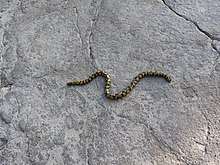Uropeltis shorttii
Uropeltis shorttii, also known as the Shevaroy Hills earth snake[1] or Shortt's shieldtail snake,[2] is a species of non-venomous snake endemic to the Southern Eastern Ghats of India.[1] This species was first described as Silybura shorttii by Richard Henry Beddome, in 1863.[3] It is found only in the Shevaroy Hills of Salem district in Tamil Nadu state in South India.[2] This species was misclassified into Uropeltis ceylanica, a snake endemic to the Western Ghats, for a long time, till a recent taxonomic study[4] proved it to be a distinct species with a very narrow geographic range. It is a burrowing snake, presumed to be nocturnal; feeding on soft-bodied worms. Becomes active during the rains. This is a "data deficient" species, as it is yet to assessed for its conservation status.[5]
| Uropeltis shorttii | |
|---|---|
 | |
| Scientific classification | |
| Kingdom: | Animalia |
| Phylum: | Chordata |
| Class: | Reptilia |
| Order: | Squamata |
| Suborder: | Serpentes |
| Family: | Uropeltidae |
| Genus: | Uropeltis |
| Species: | U. shorttii |
| Binomial name | |
| Uropeltis shorttii (Beddome, 1863) | |
| Synonyms | |
| |
Description
A small (< 30 cm (12 in) long) dark bluish black coloured burrowing snake, with distinct yellow cross bands across. Rostral visible from above, smaller than nasal, not completely separating nasals; nasals in contact with one another posteriorly, prefrontals not in contact with rostral, subequal in size to nasal and ocular scales; nasals pierced by nostril, divided by rostral anteriorly but in contact with each other posteriorly; prefrontals somewhat larger than nasals and oculars, subequal to frontal; frontal longer than broad, distinctly smaller than parietal; parietals large, largest of all head scales; supralabials 4,4 (left, right), 1st and 2nd ones small, 3rd below eye, 4th the largest; infralabials 3,3 (left, right), elongate; mental scale small, subequal to 1st infralabial, but as wide as long; body scales imbricate, cycloid; dorsally around body in 19 (one head length after neck): 17 (at midbody): 17–15 (one head length before vent) rows; ventrals 141–156 (148.5±10.6), angulate laterally; anals 2, left overlapping right, each larger than a body scale; subcaudals 10–12 pairs +1 terminal scale; tail shield distinctly truncate above, mildly concave, circumscribed and ridged; covered with 30–31 (30.5±0.7), bi- and tri-carinate thickened scales; 10 scales across the length and 4–5 (4.5±0.6) across the width of the tail shield.[4]
Colouration
The dorsum is dark coffee brown with distinct bright yellow cross bars formed by series of yellow blotches across consecutive scales in dorsal scale rows; 34–47 (41±7.0) such cross bars present on body and tail; venter largely yellowish with dark brown spots and blotches, the dark spots restricted mostly to either side where ventral scales contact the outermost coastal scale rows; a pair of thick yellow stripes anteriorly along the neck and forebody on scale rows 3–5, the stripes extending to the level of the 36th–48th (42±8.4) ventral scale; the stripe passing through lower half of supralabials, below the ocular scale and upper half of infralabials; eye pale whitish-grey; inside of mouth pale pink; tongue of same colour, its tips lighter.
Etymology
Named after its collector Dr. John Shortt, a medical physician with the then Madras Army, who donated the type specimens to Col. Richard Henry Beddome, who first described this species.[1]
References
- Uropeltis shorttii at the Reptarium.cz Reptile Database. Accessed 30 January 2019.
- Ganesh, S. R. & M. Arumugam (2016). "Species richness of montane herpetofauna of southern Eastern Ghats, India: A historical resume and a descriptive checklist". Russian Journal of Herpetology. 23 (1): 7–24.
- Beddome, R. H. (1863). "Further notes upon the snakes of the Madras Presidency; with descriptions of new species". Madras Quarterly Journal of Medical Science. 6: 41–48 – via Biodiversity Heritage Library.
- Ganesh, S.R.; R. Aengals & Eric Ramanujam (2014). "Taxonomic reassessment of two Indian shieldtail snakes in the Uropeltis ceylanicus species group (Reptilia: Uropeltidae)". Journal of Threatened Taxa. 6 (1): 5305–5314. doi:10.11609/jott.o3636.5305-14.
- Pyron, R. A.; Ganesh, S. R.; Sayyed, A.; Sharma, V.; Wallach, V. & Somaweera, R. (2016). "A catalogue and systematic overview of the shield-tailed snakes (Serpentes: Uropeltidae)" (PDF). Zoosystema. 38 (4): 453–506. doi:10.5252/z2016n4a2 – via BioOne.